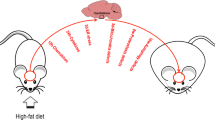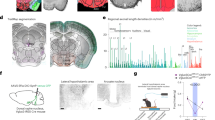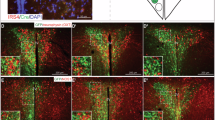Abstract
Early lesion studies and subsequent genetic findings identified the hypothalamus as an important regulator of appetite, food intake and energy expenditure. Over the past 10 years, increasing attention has been dedicated to delineating the hypothalamic blueprint of metabolism regulation, in the hope of developing successful strategies to combat metabolic disorders. However, recent developments indicate that the hypothalamic wiring of feeding circuits changes continuously in the face of varying metabolic parameters. These unexpected findings indicate that new therapeutic avenues might emerge from a complete understanding of synaptic plasticity in the hypothalamus.
This is a preview of subscription content, access via your institution
Access options
Subscribe to this journal
Receive 12 print issues and online access
$189.00 per year
only $15.75 per issue
Buy this article
- Purchase on Springer Link
- Instant access to full article PDF
Prices may be subject to local taxes which are calculated during checkout


Similar content being viewed by others
References
Friedman, J. M. & Halaas, J. L. Leptin and the regulation of body weight in mammals. Nature 395, 763–770 (1998).
Elmquist, J. K., Elias, C. F. & Saper, C. B. From lesions to leptin: hypothalamic control of food intake and body weight. Neuron 22, 221–232 (1999).
Kalra, S. P. et al. Interacting appetite-regulating pathways in the hypothalamic regulation of body weight. Endocr. Rev. 20, 68–100 (1999).
Schwartz, M. W., Woods, S. C., Porte, D. Jr, Seeley, R. J. & Baskin, D. G. Central nervous system control of food intake. Nature 404, 661–671 (2000).
Seeley, R. J. & Woods, S. C. Monitoring of stored and available fuel by the CNS: implications for obesity. Nature Rev. Neurosci. 4, 901–909 (2003).
Horvath, T. L., Diano, S. & Tschop, M. Brain circuits regulating energy homeostasis. Neuroscientist 10, 235–246 (2004).
Hetherington, A. W. The relation of various hypothalamic lesions to adiposity and other phenomena in the rat. Am. J. Physiol. 133, 326 (1941).
Hetherington, A. W. & Ranson, S. W. The relation of various hypothalamic lesions to adiposity in the rat. J. Comp. Neurol. 76, 475 (1942).
Hetherington, A. W. Non-production of hypothalamic obesity in the rat by lesions rostral or dorsal to the ventromedial hypothalamic nuclei. J. Comp. Neurol. 80, 33 (1944).
Brobeck, J. R., Tepperman, J. & Long, C. N. H. Experimental hypothalamic hyperphagia in the albino rat. Yale J. Biol. Med. 15, 831 (1943).
Brobeck, J. R. Mechanism of the development of obesity in animals with hypothalamic lesions. Physiol. Rev. 26, 541–559 (1946).
Anand, B. K. & Brobeck, J. R. Hypothalamic control of food intake in rats and cats. Yale J. Biol. Med. 24, 123–146 (1951).
Coleman, D. L. Diabetes-obesity syndromes in mice. Diabetes 31, 1–6 (1982).
Zucker, L. M. & Zucker, T. F. Fatty, a new mutation in the rat. J. Hered. 52, 275–278 (1961).
Sherrington, C. S. in Textbook of Physiology (ed. Sharpey-Schaefer, E. A.) 920–1001 (Edinburgh, Pentland, 1900).
Zhang, Y. et al. Positional cloning of the mouse obese gene and its human homologue. Nature 372, 425–432 (1994).
Halaas, J. L. et al. Weight-reducing effects of the plasma protein encoded by the obese gene. Science 269, 543–546 (1995).
Pelleymounter, M. A. et al. Effects of the obese gene product on body weight regulation in ob/ob mice. Science 269, 540–543 (1995).
Campfield, L. A., Smith, F. J., Guisez, Y., Devos, R. & Burn, P. Recombinant mouse OB protein: evidence for a peripheral signal linking adiposity and central neural networks. Science 269, 546–549 (1995).
Leibel, R. L., Chung, W. K. & Chua, S. C. Jr The molecular genetics of rodent single gene obesities. J. Biol. Chem. 272, 31937–31940 (1997).
Montague, C. T. et al. Congenital leptin deficiency is associated with severe early-onset obesity in humans. Nature 387, 903–908 (1997).
Clement, K. et al. A mutation in the human leptin receptor gene causes obesity and pituitary dysfunction. Nature 392, 398–401 (1998).
Mercer, J. G. et al. Localization of leptin receptor mRNA and the long splice variant (O-Rb) in mouse hypothalamus and adjacent brain regions by in situ hybridization. FEBS Lett. 387, 113–116 (1996).
Schwartz, M. W., Seeley, R. J., Campfield, L. A., Burn, P. & Baskin, D. G. Identification of leptin action in rat hypothalamus. J. Clin. Invest. 98, 1101–1106 (1996).
Mayer, J. Regulation of energy intake and body weight: the glucostatic theory and the lipostatic hypothesis. Ann. NY Acad. Sci. 63, 15 (1955).
Bernstein, L. M. & Grossman, M. I. An experimental test of the glucostatic theory of regulation of food intake. J. Clin. Invest. 35, 627–633 (1956).
Andik, I. & Donhoffer, S. The effect of insulin on food intake and selection of mice. Z. Vitam. Horm. Fermentforsch. 3, 208–212 (1949–1950).
Sipols, A. J., Baskin, D. G. & Schwartz, M. W. Effect of intracerebroventricular insulin infusion on diabetic hyperphagia and hypothalamic neuropeptide gene expression. Diabetes 44, 147–151 (1995).
Smith, G. P. & Gibbs, J. Cholecystokinin: a putative satiety signal. Pharmacol. Biochem. Behav. 3, 135–138 (1975).
Sturdevant, R. A. & Goetz, H. Cholecystokinin both stimulates and inhibits human food intake. Nature 261, 713–715 (1976).
Turton, M. D. et al. A role for glucagon-like peptide-1 in the central regulation of feeding. Nature 379, 69–72 (1996).
Tschop, M., Smiley, D. L. & Heiman, M. L. Ghrelin induces adiposity in rodents. Nature 407, 908–913 (2000).
Clark, J. T., Kalra, P. S., Crowley, W. R. & Kalra, S. P. Neuropeptide Y and human pancreatic polypeptide stimulate feeding behavior in rats. Endocrinology 115, 427–429 (1984).
Batterham, R. L. et al. Gut hormone PYY(3-36) physiologically inhibits food intake. Nature 418, 650–654 (2002).
Strominger, J. L. & Brobeck, J. R. A mechanism of regulation of food intake. Yale J. Biol. Med. 25, 383–390 (1953).
Cannon, W. B. & Washburn, A. L. An explanation of hunger. Am. J. Physiol. 29, 441 (1912).
Carlson, A. J. The Control of Hunger in Health and Disease (Chicago Univ. Press, Chicago, 1916).
Guy-Grand, B. Clinical studies with dexfenfluramine: from past to future. Obes. Res. 3 (suppl.), 491S–496S (1995).
Heisler, L. K. et al. Activation of central melanocortin pathways by fenfluramine. Science 297, 609–611 (2002).
Di Marzo, V. et al. Leptin-regulated endocannabinoids are involved in maintaining food intake. Nature 410, 822–825 (2001).
Cota, D. et al. The endogenous cannabinoid system affects energy balance via central orexigenic drive and peripheral lipogenesis. J. Clin. Invest. 112, 423–431 (2003).
Wellman, P. J. & Maher, T. J. Synergistic interactions between fenfluramine and phentermine. Int. J. Obes. Relat. Metab. Disord. 23, 723–732 (1999).
Fernandez, J. R. & Allison, D. B. Rimonabant Sanofi-Synthelabo. Curr. Opin. Investig. Drugs. 5, 430–435 (2004).
Grandison, L. & Guidotti, A. Stimulation of food intake by muscimol and beta endorphin. Neuropharmacology 16, 533–536 (1977).
Bunyan, J., Murrell, E. A. & Shah, P. P. The induction of obesity in rodents by means of monosodium glutamate. Br. J. Nutr. 35, 25–39 (1976).
Levine, A. S. & Morley, J. E. Neuropeptide Y: a potent inducer of consummatory behavior in rats. Peptides 5, 1025–1029 (1984).
Stanley, B. G. & Leibowitz, S. F. Neuropeptide Y: stimulation of feeding and drinking by injection into the paraventricular nucleus. Life Sci. 35, 2635–2642 (1984).
Kyrkouli, S. E., Stanley, B. G., Seirafi, R. D. & Leibowitz, S. F. Stimulation of feeding by galanin: anatomical localization and behavioral specificity of this peptide's effects in the brain. Peptides 11, 995–1001 (1990).
Blundell, J. E. & Latham, C. J. Serotonergic influences on food intake: effect of 5-hydroxytryptophan on parameters of feeding behaviour in deprived and free-feeding rats. Pharmacol. Biochem. Behav. 11, 431–437 (1979).
Sommer, S. R., Novin, D. & LeVine, M. Food and water intake after intrahypothalamic injections of carbachol in the rabbit. Science 156, 983–984 (1967).
Qu, D. et al. A role for melanin-concentrating hormone in the central regulation of feeding behavior. Nature 380, 243–247 (1996).
Sakurai, T. et al. Orexins and orexin receptors: a family of hypothalamic neuropeptides and G protein-coupled receptors that regulate feeding behavior. Cell 92, 573–585 (1998).
Mercer, J. G. et al. Coexpression of leptin receptor and neproneuropeptide Y mRNA in arcuate nucleus of mouse hypothalamus. J. Neuroendocrinol. 8, 733–735 (1996).
Erickson, J. C., Hollopeter, G. & Palmiter, R. D. Attenuation of the obesity syndrome of ob/ob mice by the loss of neuropeptide Y. Science 274, 1704–1707 (1996).
Hahn, T. M., Breininger, J. F., Baskin, D. G. & Schwartz, M. W. Coexpression of Agrp and NPY in fasting-activated hypothalamic neurons. Nature Neurosci. 1, 271–272 (1998).
Fan, W., Boston, B. A., Kesterson, R. A., Hruby, V. J. & Cone, R. D. Role of melanocortinergic neurons in feeding and the agouti obesity syndrome. Nature 385, 165–168 (1997).
Huszar, D. et al. Targeted disruption of the melanocortin-4 receptor results in obesity in mice. Cell 88, 131–141 (1997).
Seeley, R. J. et al. Melanocortin receptors in leptin effects. Nature 390, 349 (1997).
Zigman, J. M. & Elmquist, J. K. From anorexia to obesity — the yin and yang of body weight control. Endocrinology 144, 3749–3756 (2003).
Ollmann, M. M. et al. Antagonism of central melanocortin receptors in vitro and in vivo by agouti-related protein. Science 278, 135–138 (1997).
van den Pol, A. N. Weighing the role of hypothalamic feeding neurotransmitters. Neuron 40, 1059–1061 (2003).
Theodosis, D. T. & Poulain, D. A. Evidence for structural plasticity in the supraoptic nucleus of the rat hypothalamus in relation to gestation and lactation. Neuroscience 11, 183–193 (1984).
Theodosis, D. T., Montagnese, C., Rodriguez, F., Vincent, J. D. & Poulain, D. A. Oxytocin induces morphological plasticity in the adult hypothalamo-neurohypophysial system. Nature 322, 738–740 (1986).
Langle, S. L., Poulain, D. A. & Theodosis, D. T. Induction of rapid, activity-dependent neuronal-glial remodelling in the adult rat hypothalamus in vitro. Eur. J. Neurosci. 18, 206–214 (2003).
Garcia-Segura, L. M., Baetens, D. & Naftolin, F. Synaptic remodelling in arcuate nucleus after injection of estradiol valerate in adult female rats. Brain Res. 366, 131–136 (1986).
Matsumoto, A. & Arai, Y. Neuronal plasticity in the deafferented hypothalamic arcuate nucleus of adult female rats and its enhancement by treatment with estrogen. J. Comp. Neurol. 197, 197–205 (1981).
Matsumoto, A. & Arai, Y. Synaptogenic effect of estrogen on the hypothalamic arcuate nucleus of the adult female rat. Cell Tissue Res. 198, 427–433 (1979).
Garcia-Segura, L. M., Olmos, G., Tranque, P. & Naftolin, F. Rapid effects of gonadal steroids upon hypothalamic neuronal membrane ultrastructure. J. Steroid Biochem. 27, 615–623 (1987).
Naftolin, F. et al. Synaptic remodeling in the arcuate nucleus during the estrous cycle is induced by estrogen and precedes the preovulatory gonadotropin surge. Endocrinology 137, 5576–5580 (1996).
Horvath, T. L., Garcia-Segura, L. M. & Naftolin, F. Control of gonadotropin feedback: the possible role of estrogen-induced hypothalamic synaptic plasticity. Gynecol. Endocrinol. 11, 139–143 (1997).
Horvath, T. L., Naftolin, F., Kalra, S. P. & Leranth, C. Neuropeptide-Y innervation of beta-endorphin-containing cells in the rat mediobasal hypothalamus: a light and electron microscopic double immunostaining analysis. Endocrinology 131, 2461–2467 (1992).
Diano, S., Kalra, S. P., Sakamoto, H. & Horvath, T. L. Leptin receptors in estrogen receptor-containing neurons of the female rat hypothalamus. Brain Res. 812, 256–259 (1998).
Cowley, M. A. et al. Leptin activates anorexigenic POMC neurons through a neural network in the arcuate nucleus. Nature 411, 480–484 (2001).
Pinto, S. et al. Rapid re-wiring of arcuate nucleus feeding circuits by leptin. Science 304, 110–115 (2004).
Eccles, J. in The Physiology of Synapses (Springer, Berlin, 1964).
Bouret, S. G., Draper, S. J. & Simerly, R. B. Trophic action of leptin on hypothalamic neurons that regulate feeding. Science 304, 108–110 (2004).
Bouret, S. G. & Simerly, R. B. Minireview: Leptin and development of hypothalamic feeding circuits. Endocrinology 145, 2621–2626 (2004).
Horvath, T. L., Diano, S. & van den Pol, A. N. Synaptic interaction between hypocretin (orexin) and NPY cells in the rodent and primate hypothalamus — a novel hypothalamic circuit implicated in metabolic and endocrine regulations. J. Neurosci. 19, 1072–1087 (1999).
Vaisse, C. et al. Leptin activation of Stat3 in the hypothalamus of wild-type and ob/ob mice but not db/db mice. Nature Genet. 14, 95–97 (1996).
Bates, S. H. et al. STAT3 signalling is required for leptin regulation of energy balance but not reproduction. Nature 421, 856–859 (2003).
Gao, Q. et al. Disruption of neural signal transducer and activator of transcription 3 causes obesity, diabetes, infertility, and thermal dysregulation. Proc. Natl Acad. Sci. USA 101, 4661–4666 (2004).
Soares, S., von Boxberg, Y., Ravaille-Veron, M., Vincent, J. D. & Nothias, F. Morphofunctional plasticity in the adult hypothalamus induces regulation of polysialic acid-neural cell adhesion molecule through changing activity and expression levels of polysialyltransferases. J. Neurosci. 20, 2551–2557 (2000).
Hoyk, Z., Parducz, A. & Theodosis, D. T. The highly sialylated isoform of the neural cell adhesion molecule is required for estradiol-induced morphological synaptic plasticity in the adult arcuate nucleus. Eur. J. Neurosci. 13, 649–656 (2001).
Parducz, A., Perez, J. & Garcia-Segura, L. M. Estradiol induces plasticity of GABAergic synapses in the hypothalamus. Neuroscience 53, 395–401 (1993).
Acampora, D. et al. Progressive impairment of developing neuroendocrine cell lineages in the hypothalamus of mice lacking the Orthopedia gene. Genes Dev. 13, 2787–2800 (1999).
Diano, S., Naftolin, F., Goglia, F. & Horvath, T. L. Fasting-induced increase in type II iodothyronine deiodinase activity and messenger ribonucleic acid levels is not reversed by thyroxine in the rat hypothalamus. Endocrinology 139, 2879–2884 (1998).
Horvath, T. L. et al. Brain UCP2: uncoupled neuronal mitochondria predict thermal synapses in homeostatic centers. J. Neurosci. 19, 10417–10427 (1999).
Lanni, A., Moreno, M., Lombardi, A. & Goglia, F. Thyroid hormone and uncoupling proteins. FEBS Lett. 543, 5–10 (2003).
Diano, S. et al. Uncouling protein 2 prevents neuronal death including that occurring during seizures: a mechanism for pre-conditioning. Endocrinology 144, 5014–5021 (2003).
Andersson, U. et al. AMP-activated protein kinase plays a role in the control of food intake. J. Biol. Chem. 279, 12005–12008 (2004).
Minokoshi, Y. et al. AMP-kinase regulates food intake by responding to hormonal and nutrient signals in the hypothalamus. Nature 428, 569–574 (2004).
Minokoshi, Y. & Kahn, B. B. Role of AMP-activated protein kinase in leptin-induced fatty acid oxidation in muscle. Biochem. Soc. Trans. 31, 196–201 (2003).
Echtay, K. S. et al. Superoxide activates mitochondrial uncoupling proteins. Nature 415, 96–99 (2002).
van den Top, M., Lee, K., Whyment, A. D., Blanks, A. M. & Spanswick, D. Orexigen-sensitive NPY/AgRP pacemaker neurons in the hypothalamic arcuate nucleus. Nature Neurosci. 7, 493–494 (2004).
Woolley, C. S. & McEwen, B. S. Estradiol regulates hippocampal dendritic spine density via an N-methyl-D-aspartate receptor-dependent mechanism. J. Neurosci. 14, 7680–7687 (1994).
Leranth, C., Shanabrough, M. & Horvath, T. L. Hormonal regulation of hippocampal spine synapse density involves subcortical mediation. Neuroscience 101, 349–356 (2000).
Gustafson, D., Rothenberg, E., Blennow, K., Steen, B. & Skoog, I. An 18-year follow-up of overweight and risk of Alzheimer disease. Arch. Intern. Med. 163, 1524–1528 (2003).
Li, X. L. et al. Impairment of long-term potentiation and spatial memory in leptin receptor-deficient rodents. Neuroscience 113, 607–615 (2002).
Acknowledgements
Research projects of the authors associated with mechanisms discussed in this paper have been supported by the following institutes of the National Institute of Health (NIH): NCRR, NIA, NIDDK, NIMH and NINDS.
Author information
Authors and Affiliations
Corresponding author
Ethics declarations
Competing interests
The authors declare no competing financial interests.
Rights and permissions
About this article
Cite this article
Horvath, T., Diano, S. The floating blueprint of hypothalamic feeding circuits. Nat Rev Neurosci 5, 662–667 (2004). https://doi.org/10.1038/nrn1479
Issue Date:
DOI: https://doi.org/10.1038/nrn1479
This article is cited by
-
Ontogenetic rules for the molecular diversification of hypothalamic neurons
Nature Reviews Neuroscience (2022)
-
Pituitary Adenylate Cyclase-Activating Polypeptide in the Ventromedial Hypothalamus Is Responsible for Food Intake Behavior by Modulating the Expression of Agouti-Related Peptide in Mice
Molecular Neurobiology (2020)
-
Dissecting the hypothalamic pathways that underlie innate behaviors
Neuroscience Bulletin (2015)
-
Central (mainly) actions of GPCRs in energy homeostasis/balance: view from the Chair
International Journal of Obesity Supplements (2014)
-
Molecular and cellular regulation of hypothalamic melanocortin neurons controlling food intake and energy metabolism
Molecular Psychiatry (2014)



